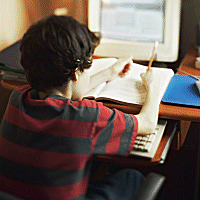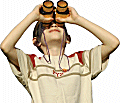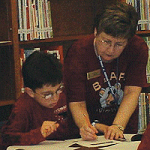A War of Words
##AUTHORSPLIT##<--->
Software programs developed to combat the scourge of student plagiarism havefound opposition from the very circle of educators they're meant to help.
 THERE WAS SOMETHING DIFFERENT aboutthe batch of note cards Maribeth Mohan received this pastyear from the students in her senior composition class. Theyweren't ragged or wrapped in rubber bands, or half-filled withchicken scratch, lifted word for word from an encyclopedia,the way they'd been so often in the past. Instead they wereneat and well organized, with the original material presentedalongside the students' own, paraphrased thoughts.
THERE WAS SOMETHING DIFFERENT aboutthe batch of note cards Maribeth Mohan received this pastyear from the students in her senior composition class. Theyweren't ragged or wrapped in rubber bands, or half-filled withchicken scratch, lifted word for word from an encyclopedia,the way they'd been so often in the past. Instead they wereneat and well organized, with the original material presentedalongside the students' own, paraphrased thoughts.
"After 34 years of messing with lost or incomplete note cards, rubber-banded together and very disorganized—and plagiarism issues of all sorts—this was a real breath of fresh air," says Mohan, a teacher at Glenbard High School in Glen Ellyn, IL. The difference between last year's class and ones previous? Last year's group of students used PaperToolsPro, one in a torrent of software programs created over the last 10 years to fight the internet-energized plagiarism epidemic that has infected schools. Mohan says PTP helps her encourage students to use proper research techniques and shows them plainly the difference between plagiarizing and paraphrasing. The software enables students to search for material in an organized fashion and guides them through the process of citing sources, allowing them to assemble their research on note cards that can be sorted various ways and then placed into a word processing document.
Mohan's approach is a proactive measure to ward off student plagiarism, as opposed to the more reactionary applications that have found a number of opponents among the very population they purport to help: educators. One of those unlikely critics is Charlie Lowe, a writing professor at Grand Valley State University near Grand Rapids, MI, and spokesperson for the 6,000-member Conference on College Composition and Communication, which has published a position paper critical of anti-plagiarism programs. CCCC is among those arguing that the spate of new plagiarism detectors creates the wrong atmosphere for writing, finds a student guilty until proven innocent, and infringes on student rights. The group is especially opposed to products that put student papers in a database to be compared against others, such as iParadigms' popular Turnitin.com, which acquires and inspects student work.
"We have to teach students about plagiarism," Lowe says, "but if all we do is catch them without taking responsibility for the process, how do they learn about the proper use of research material? Technology is no substitute for good teaching."

SITE SEEING
www.copycatchgold.com An anti-plagiarism tool instructs studentson how to do research correctly.
Created by a British company, Computational ForensicLinguistics (CFL) Software Development, CopyCatch Goldoffers a suite of products including a search detectionservice and a program that helps students cite researchappropriately. David Woolls, founder of CFL Software Development,says CopyChecker, a program that comes freewith CopyCatch, shows students how to avoid plagiarismwith two options similar to those offered by PaperToolsPro.
A "notes with work" function offers a split screen where source data can be stored and the student can type. Users can also cut and paste, but the program reminds them to cite the resource and helps them do it correctly. The students can press a "compare" button to see the level of similarity between the original and their own writing, and the program points out where there may not be enough distance.
The "freehand" function allows students to access original material they have found, but not while they are writing, simulating the effect of going back to check on data.
Lowe questions the ethics of releasing student essays to a business that then uses them against other students. "We are asking students to give their text to these companies so the companies can make money off it," he says. Students at Virginia's McLean High School are of a similar mind as the professor. Last fall they collected about 1,200 names on a petition protesting the use of Turnitin because they said it infringed on their intellectual property rights and assumed guilt.
Users should also realize that anti-plagiarism programs have their shortcomings. They may not check books or subscription services; they don't detect plagiary of ideas; and they can give false positives or, conversely, clear a paper without any real assurance that nothing has been copied. Some critics also suggest that, in time, students simply will find ways around them. Russ Hunt, a professor at Canada's St. Thomas University in New Brunswick, and an outspoken opponent of plagiarism detection tools, imagines a program that runs a thesaurus through an existing text, making enough word substitutions that the cheating would be undetectable by essay-comparison software. "How hard is that?" Hunt says. "I'm surprised I'm not already seeing it advertised."
Rebecca Moore Howard, associate professor of writing and rhetoric at Syracuse University, says that detection applications are more about policing than teaching. "They tell students when they have failed to write well, but they don't teach them how to write well," she says. "Plagiarism detection software teaches students that writing assignments are a cat-and-mouse game in which they are the teacher's adversary."
TEACHING, NOT POLICING
IF YOU'VE RECENTLY spent any time as a student at Blattman Elementary School in San Antonio, then you're sure to have been exposed to "trash and treasure," amethod of note-taking that Blattman librarian Linda Miller (see "The New Librarians,"August) teaches kids to show them theproper way to do research while warning them about the evils of plagiarizing.
Before she begins the activity, which involves separating relevant from irrelevant information, Miller says she explains "how copying everything the author wrote is called plagiarism and is stealing, and that it is important to also write down where we get our information or cite our sources."
 She tailors trash and treasure to eachgrade level. For example, she says she getsher point across to second-graders with a littlerole-playing. "I pretend that I've seen abeautiful drawing by a student and haveasked the art teacher if I can hang it in thelibrary. I use a blank piece of paper to representthe drawing, tape it to the wall, lookaround furtively, then pretend to erase thestudent's name and put my name on it. Thestudents yell at me, 'That's not fair! That's stealing!' Second-graders are appalledby stealing. I explain that, yes, it is, and that if they do that with a book or somesource, they will be doing the same thing."
She tailors trash and treasure to eachgrade level. For example, she says she getsher point across to second-graders with a littlerole-playing. "I pretend that I've seen abeautiful drawing by a student and haveasked the art teacher if I can hang it in thelibrary. I use a blank piece of paper to representthe drawing, tape it to the wall, lookaround furtively, then pretend to erase thestudent's name and put my name on it. Thestudents yell at me, 'That's not fair! That's stealing!' Second-graders are appalledby stealing. I explain that, yes, it is, and that if they do that with a book or somesource, they will be doing the same thing."
Then it's on to the business of note-taking. Miller passes out copies of a page from a book or website on a topic related to the research the students will be doing. She uses an LCD projector that has a document camera attached so the students can watch her hand and pencil as she works with the text to demonstrate the trash-and-treasure technique.
"We go over the questions we want to answer so we know what we're looking for, then we read a sentence at a time from the printed text," she says. "If the information is relevant to a question, we circle the 'treasure,' or words we must have, and we 'slash the trash.'"
Once the students take the information from a source, they credit the source in the box provided on a data chart. The chart provides a format for students to jot down only pertinent information—the treasure—while citing where they got it from.
"The last step," Miller says, "is to take our 'treasure' and rewrite it in our own words into good sentences and paragraphs."
The founder of Turnitin's anti-plagiarism application, John Barrie, who developed the system as a graduate student to help instructors and students respond to online cheating, says the service is just a tool, like the computer itself, working best in concert with a good teacher. He compares it to a proctor at a test or a referee on a field, whose presence doesn't imply everyone is cheating or playing unfairly.
His company now promotes its three-step process— checking a work for originality, allowing for peer review, and enabling the teacher to grade the work more quickly online than would be possible manually. And he recommends teachers use the company's brand-new Learning Center, which helps students learn appropriate ways to do research.
Barrie says his product came on the scene at a time of an epidemic of plagiarism. "Students were using the internet like an 8-billion-page cut-and-paste encyclopedia," he says, "buying term papers online and e-mailing manuscripts to friends—and nothing had stopped the problem until the arrival of Turnitin." Barrie claims his company, which receives some 60,000 assignments into its database daily and is used by about 6,000 schools, has cut plagiarism rates by more than 80 percent on the campuses where it is used.
"Plagiarism detection software teaches studentsthat writing assignments are a cat-and-mousegame in which they are the teacher's adversary."
—Rebecca Moore Howard, Syracuse University
Barrie and other makers of anti-plagiarism programs say their tools work best as a deterrent. They advise teachers to forcefully advertise their potential use of the applications; the threat of being caught is often enough to halt potential student copying. A study printed in the journal PS: Political Science and Politics showed that telling students about the use of a detection tool dramatically diminished plagiarism, while simply warning them not to plagiarize had, according to the report, "no effect whatsoever."
"Students were using theinternet like an 8-billion-pagecut-and-paste encyclopedia…andnothing had stopped the problemuntil the arrival of Turnitin."
—John Barrie, Turnitin
At Glenbard High, however, Maribeth Mohan hasn't had to resort to warnings or threats. Instead, she wields technology as a means to help students do the right thing rather than to nab them doing the wrong thing. Her 31 composition students cut and paste relevant material they have found onto a note card, then are required to paraphrase the material, with Mohan's guidance. Next, they are prompted to cite the information properly, and finally, they organize the notes into an outline or a draft document electronically.
BYTESIZE
The Conference on College Compositionand Communications' positionpaper on plagiarism can be foundhere.
"Paraphrasing is more accurate because [the students] can see original material as they paraphrase it," Mohan explains, "and they have a much easier time organizing material from their note cards and can reorder them quickly, then begin their papers. They begin to feel good as they see these note cards accumulating in an organized way.
"Students have the original source in front of them, and they can see what a paraphrase looks like on their note card right below the source material." Mohan explains that the antidote to plagiarism is teaching: "I have not used plagiarism detection tools, other than just running a Google search of a grouping of words, but that is all after the fact and does nothing to teach the students how not to plagiarize in the first place. I do believe some plagiarism is deliberate, but some occurs because we just do not really teach what it means to paraphrase or what is quote-worthy material. [What I use] is a teaching tool, not a detection tool, and that is a significant difference."
-Jim Paterson is a freelance writer basedin Maryland.